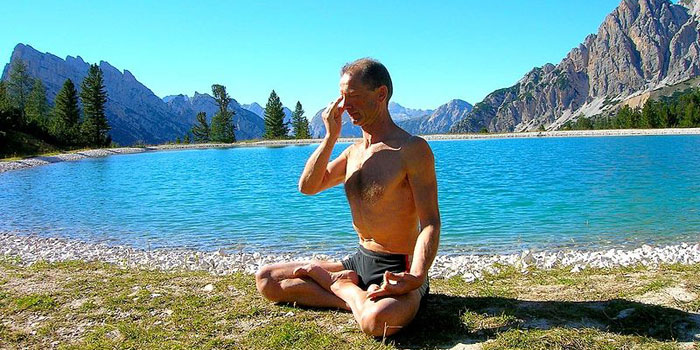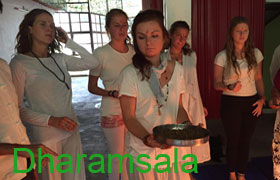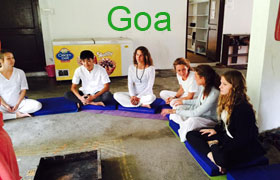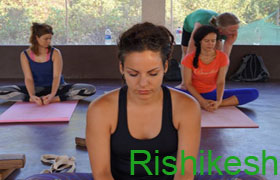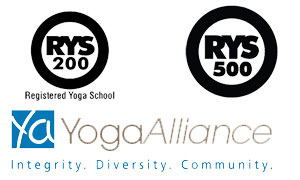Kapalbhati Techniques
Kapalbhati falls under the category of cleansing techniques. It purifies our physical and mental disorders. Therefore this topic is discussed under the section of cleansing techniques.
Chandrabhedan Paranayam
The left nostril represents the characteristics of moon as mentioned earlier. This pranayama involves breathing air exclusively through Chandra nadi. Hence it is called Chandrabhedan pranayama.
Procedure
Close your right nostril and practice poorak with your left nostril. Observe the bandhas in their predefined order and lock the air inside as per your stamina. Then release the bandhas in the predefined order. Now practice rechak through your right nostril. Again practice poorak with the left nostril and rechak with the right nostril. Initially you can practice this for 10 to 20 cycles of repetitions. You increase the repetitions count based on your ability.
Benefits
1. Practicing chandrabhedan pranayama in summer proves to be very helpful.
2. This pranayama cools down the body.
3. It can improve the mental peace.
4. Highly beneficial for high blood pressure.
5. It can alleviate all the stress.
6. It can make the body gentle, quiet and attractive.
According to Hath yoga pradeepika, there are eight types of kumbhak.
सूर्यभेदनमुज्जई सीत्कारी शीतली तथा |
भस्त्रिका भ्रामरी मूर्छा प्लाविनित्यष्टकुम्भकः || (ह० प्र०)
Suryabhedana Pranayama
Procedure
Surya nadi is the main nerve involved in this pranayama. Thus it is called the suryabhedana paranayama. In order to practice this asana you can sit in any posture such as padmasana, siddhasana or any other asana in which you can sit comfortably for a very long time. Now close your left nostril with your ring finger and the little finger of your right hand and deeply inhale the air through your right nostril such that you feel the pressure of the inhaled air throughout your body. Then apply jalandhara bandha followed by moola bandha and uddiyana bandha in order. Pause in this posture as long as you can and observe kumbhak. When you can no more hold the air inside exhale it through the left nostril. You can repeat this for five to 25 times.
Benefits
The main advantage of this pranayama is that the five vayu namely prana, apana, saman, udan and vyan flow through the surya nadi. This flow raises the temperature of these vayus and causes them to flow upwards and restricts their flow downwards. This pranayama is also helpful in dealing with obesity.
Precautions
This pranayama should not be practiced if your suffer with heart problem, high blood pressure or fever because this pranayama raises the temperature of the body which might cause further complications in these cases. This should be practiced exclusively under the supervision of an expert.
Ujjayi Pranayama
Ujjayi is the combination two Sanskrit words ud and jayi. Ud means to shout or chant and jayi means success. The seeker of pranayama always aims at success. This pranayama also can be practiced in any meditative posture such as padmasana, vajrasana etc. You should inhale air as much as possible through both of your nostrils making noise through your throat. You must close your mouth tight while you inhale air so that no air can enter through your mouth. So in way you should practice poorak simultaneously with both of your nostrils followed by kumbhak as per your stamina. When you feel you cannot hold the air anymore you should exhale it through your left nostril from your throat. This pranayama can be practiced without kumbhak also.
Benefits
It can eliminate all kinds of troubles related to throat. It makes your voice melodious. This pranayama mostly imparts physical benefits. It can eradicate gonorrhea, ascites, indigestion, liver related issues, spleen and other stomach related diseases, tuberculosis and fever. Apart from these it can act on phlegm related disorders too. It is also helpful in dealing with the heat in the region of head, insomnia etc.
Sheetali Pranayama
In sheetali pranayama you must inhale air through your mouth. To do this you should shrink your lips and bring your tongue outside and twist into oval shape. Now inhale through the middle part of your tongue. Then apply the three bandhas and lock air in accordance with 1:4:2 pranayaama and finally exhale the air through your nose. This can be practiced for 5 to 25 cycles of repetitions.
Sithkari Pranayama
Place both the rows of your teeth attached to each other. Keep your tongue in the middle and pull air inside making a sound like whistle with your tongue. Now apply the three bandhas and lock air for a while and practice rechak inorder to exhale air through your nose.
Benefits
Benefits of both of above mentioned pranayamas are the same. Both of them are useful in summer. They can deal will all the complications that result due to pitta dosha such as lack of hunger, being restless, anxiety, colon tumor, etc. They are highly beneficial for high blood pressure. If a person affected with high blood pressure practices these two pranayamas regularly he can get rid of this issue for ever.

